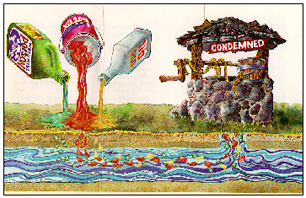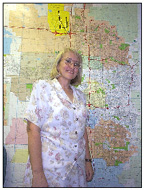Ground-water Source Protection Ordinance
September 4, 1998
|
In the Salt Lake Valley ground-water provides about 40 percent of the drinking water supply (130,000 acre-feet) to over 830,000 inhabitants from over 150 wells. In 1991, the State Department of Natural Resources, Division of Water Rights developed an interim ground-water management plan in an effort to prevent over-use of this valuable drinking water source. The State Engineer expressed concern about excessive ground-water withdrawals that could endanger the principal aquifer’s water quality. The water quality along eastern Salt Lake County is good; however, it tends to be of less quality as you move westward. Over pumping the east side could cause the migration of lower quality water from the west into the higher quality east side aquifer. Under the 1991 Interim Management Plan, the State Engineer established a number of measures to prevent excessive withdrawals, including limiting withdrawals to specific amounts within 9 ground-water management areas. For example within Salt Lake City’s service area, along eastern Salt Lake County, the total withdrawals were set at 124,800 acre-feet.
Salt Lake City depends on wells and springs to provide about 20 percent of its drinking water supply within its service area, including unincorporated Salt Lake County. This source of supply is used primarily during the summer months for supply and meeting peak demand within the distribution system. Many of the wells were first drilled during the 1930s when the area experienced a severe drought.
The need to protect the ground-water became apparent to Salt Lake City, when in 1991, the Sugar House Park Well became contaminated with PCE, a common dry cleaning solvent. In 1995, the 6200 South Well similarly became contaminated.
Florence Reynolds, Department of Public Utilities Water Quality Administrator says it’s important to protect this valuable resource. She reminds us, “that because ground-water is out of sight, it tends to be ignored when it comes to pollution.” Ms Reynolds adds, “Because the ground-water aquifer takes years to recharge, once contaminated, it may take a life time or more to clean-up.”
On July 26, 1993 the State Department of Environmental Quality, Division of Drinking Water established a “Drinking Water Source Protection Rule,” with the purpose of designating and protecting land surfaces that are contributing to water recharging the aquifer that feeds a well or spring source.
In an effort to coordinate a valley-wide protection zone and to cross over jurisdictional boundaries, all of the water entities in the valley joined together in a valley-wide ground-water study. Salt Lake City participated with the other entities in this endeavor. Some wells that belong to the City are outside the of the corporate limits of Salt Lake City, and other wells belonging to other utilities have protection zones that extend into Salt Lake City. In order to be able to adequately protect everyone’s concerns, a model ordinance was developed with the input of all the water entities. This model ordinance provided a level of protection that all water entities were willing to except for their own wells and for the wells and protection zones of other entities within their borders. Each member entity took the model ordinance and adapted it to their community without diminishing the basic level of protection. The adjustments in each adopted ground-water protection ordinance are to be at least as restrictive as the model, but could be more restrictive if the entity chose.
Land designated for protection in the Ground-water Source Protection Ordinance collects the water that ends up in the drinking water supply. The land areas designated for protection around each well head cover all the underground water that would take up to 15 years to travel to the well head. Activities in these areas need to be controlled so as to avoid adding contaminants to the water. The front facing Wasatch Mountain and foothills are porous enough to allow water directly into the ground-water aquifer. These areas, since they don’t stop (filter) the contaminants, must be carefully guarded. To accomplish this level of protection, the ordinance includes both protection areas for each well head and an overlay zone for the primary and secondary recharge areas.
|
Some communities have already passed the new ordinance. The cooperative effort of the water entities within Salt Lake County has earned the individual representatives a Region VIII EPA Environmental Achievement Award, signed by Wm. Yellowtail, Regional Administrator. Florence Reynolds and the others each received the award for their outstanding efforts to protect the valley’s ground-water resources on July 23, 1998.
Ms. Reynolds concludes, “The Ground-water Source Protection Ordinance is a major step foreword in protecting future generations drinking water supply in the Salt Lake Valley.”
Questions regarding this message should be directed to Florence Reynolds, telephone number 801-483-6864

